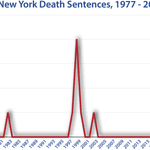
State & Federal
New York

History of the Death Penalty
New York’s hisory of capital punishment goes back to colonial times, with the second most executions of any state from 1608 to 1972, after Virginia. Before the invention of the electric chair most executions were carried out by hanging, although other methods including burning at the stake, death by firing squad, and even the breaking wheel were used. Although there were prisoners on New York’s death row until 2007, no execution has taken place since that of Eddie Mays in 1963.
Famous Cases
Perhaps the most notable execution to take place in the State of New York was that of William Kemmler in 1890. Convicted of murdering his common law wife with a hatchet, Kemmler was the first man executed with the newly developed electric chair.
Previous executions had been carried out almost exclusively by hanging. The State of New York had assigned a committee to develop a more humane method of execution. The concept of execution by means of electricity materialized after a dentist witnessed an intoxicated man die quickly and painlessly (in his estimation) after walking into exposed power lines. After several months of development, as well as a trial execution on a horse, it was determined that Kemmler would be the first to be executed in the electric chair. Kemmler’s appeal of the new method reached the U.S. Supreme Court, which upheld electrocution as a constitutional form of punishment.
On August 6th, 1890, Kemmler was strapped into the electric chair at the Auburn State Prison in front of a small group of witnesses. The switch was thrown, and a 1000 volt current passed through Kemmler’s body for 17 seconds after which he was declared dead. However, several witnesses noted that Kemmler was still breathing and heard Kemmler groaning softly. The switch was thrown again using a higher voltage. Witnesses reported an awful smell of burning flesh and singeing hair, and blood vessels beneath Kemmlers skin burst and bled. Despite the gruesome accounts of the electrcution, the electric chair soon became the dominant form of execution in the United States until its replacement with lethal injection.
Milestones in Abolition/Reinstatement
The death penalty has been abolished and reinstated several times in New York. New York’s death penalty was accidentally abolished in 1860, when the legislature passed measures that repealed hanging as a method of execution but provided no other means of carrying out a death sentence. The mistake was corrected a year later in 1861.
Lewis E. Lawes, the warden of Sing Sing Prison from 1920 – 1941, advocated for the abolition of capital punishment. Although he supervised 303 executions, Lawes believed that capital punishment was inequitable and not a deterrent. He noted that barely 1 in 80 killers was executed, and said “Did you ever see a rich man go the whole route through to the Death House? I don’t know of any.”
In 1967, a compromise law was passed allowing for a very limited death penalty. In 1972, the U.S. Supreme Court invalidated all death penalty statutes in the country in Furman v. Georgia. The New York legislature rewrote the state’s statute in 1973, providing for a mandatory death sentence for murdering a police officer, a correctional officer, or a murder in prison by an inmate serving a life sentence. In 1977, New York’s high court effectively struck down the death penalty for the murder of a police officer or a correctional officer, and a 1984 ruling struck down capital punishment for murders committed by inmates serving life sentences, effectively abolishing New York’s death penalty. From 1978 until 1994, measures repeatedly passed both houses of New York’s state legislature that would have expanded or reinstated the death penalty, only to be vetoed by governors Hugh Carey and Mario Cuomo.
In 1995 newly-elected Governor George Pataki fulfilled a campaign promise and signed legislation reinstating the death penalty in New York, designating lethal injection as the new method of execution. In 2004, that statute was declared unconstitutional by the New York Court of Appeals, and in 2007 the last remaining death sentence was reduced to life, leaving New York with a vacant death row and no viable death penalty laws. In 2008 Governor David Paterson issued an executive order requiring the removal of all execution equipment from state facilities.

Resources

News & Developments
News
Apr 07, 2025
U.S. Attorney General Directs Prosecutors to Seek Death Penalty for Luigi Mangione, Marking First Federal Death Sentence Sought By This Trump Administration
On April 1, 2025, U.S. Attorney General Pam Bondi announced she has directed acting U.S. Attorney for Manhattan, Matthew Podolsky, to seek the death penalty against Luigi Mangione for the 2024 killing of UnitedHealthcare CEO Brian Thompson. This is the first time AG Bondi has directed prosecutors to seek the death penalty since President Donald Trump assumed office in January 2025, when he issued an executive order including a call to“restore” the federal death penalty. In a…
Read MoreNews
Mar 08, 2024
Women’s History Month Profile: U.S. District Court Judge Natasha Merle
This month, DPIC celebrates Women’s History Month with weekly profiles of notable women whose work was significant in the modern death penalty era. The first entry in this series is U.S. District Court Judge…
Read MoreNews
Jan 16, 2024
U.S. Department of Justice Authorizes First Federal Death Penalty Case for Payton Gendron, Teen Who Killed Ten Black People in 2022
On January 12, 2024, the U.S. Department of Justice (DOJ) announced that it will seek a death sentence for Payton Gendron, the then-18-year-old who killed 10 Black people at a Tops supermarket in Buffalo, New York in 2022. This is the first capital case authorized by Attorney General Merrick Garland and the Biden Administration’s DOJ. The announcement came twenty months after the mass shooting and eleven months after Mr. Gendron pled guilty to state first degree murder charges and…
Read MoreNews
Mar 13, 2023
Federal Jury Returns a Life Verdict in New York for Sayfullo Saipov
On March 13, 2023, a jury in the federal death penalty prosecution of Sayfullo Saipov in New York City concluded its deliberations without coming to a unanimous decision regarding sentencing. As a result, Saipov will be sentenced to life in prison without parole. On January 26, the jury had unanimously found the defendant guilty of murdering eight people in 2017 by deliberately ramming a truck onto a crowded Manhattan bike path. Neither Saipov nor his…
Read MoreNews
Feb 02, 2023
Penalty Phase Scheduled to Begin in Federal Capital Trial of Sayfullo Saipov
Sayfullo Saipov (pictured) was found guilty in federal court on January 26, 2023 of killing eight people on a New York City bike path in 2017 by driving a truck into a crowd of people. He will now likely be the first person to face a federal capital penalty hearing during President Biden’s administration. On February 6, 2023, a jury in Manhattan will begin hearing evidence to determine whether Saipov will be sentenced to death or life without parole. The jury must vote…
Read More

